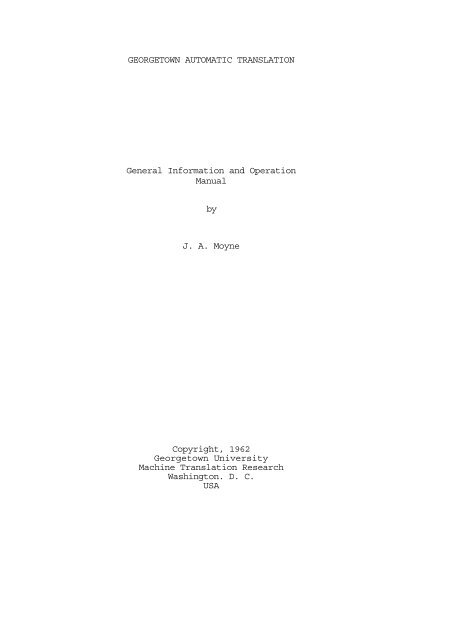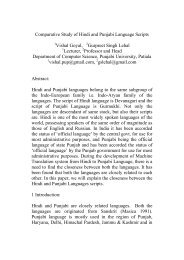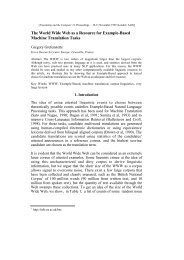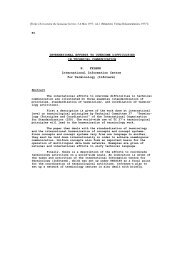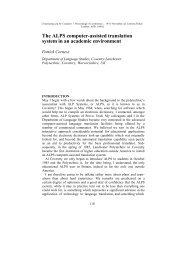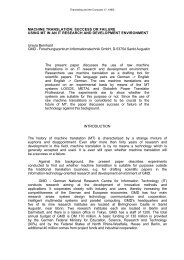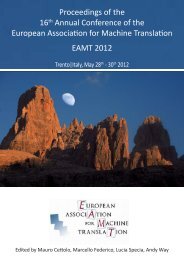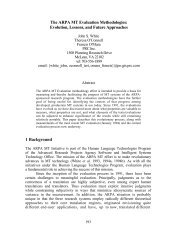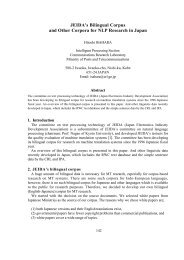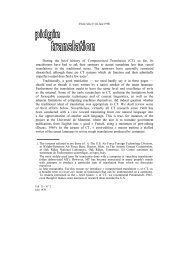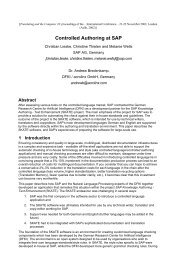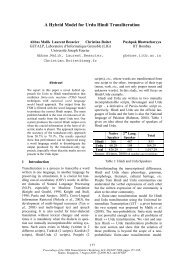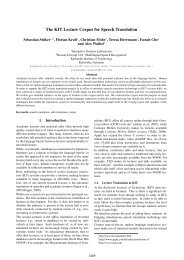Georgetown Automatic Translation: general information and ...
Georgetown Automatic Translation: general information and ...
Georgetown Automatic Translation: general information and ...
You also want an ePaper? Increase the reach of your titles
YUMPU automatically turns print PDFs into web optimized ePapers that Google loves.
GEORGETOWN AUTOMATIC TRANSLATION<br />
General Information <strong>and</strong> Operation<br />
Manual<br />
by<br />
J. A. Moyne<br />
Copyright, 1962<br />
<strong>Georgetown</strong> University<br />
Machine <strong>Translation</strong> Research<br />
Washington. D. C.<br />
USA
Foreword<br />
The <strong>Georgetown</strong> <strong>Automatic</strong> <strong>Translation</strong> * (GAT) is a result of group effort<br />
<strong>and</strong> cooperation of linguists <strong>and</strong> programmers. This publication is intended<br />
to serve as a manual of operations <strong>and</strong> reference for the programming system.<br />
The system is often referred to as the "Direct Conversion" system since it<br />
started as an undertaking for converting the running <strong>Georgetown</strong> MT system of<br />
the IBM 705 computer into the IBM 709 - 7090 computer system. In the course<br />
of "conversion", however, several major <strong>and</strong> minor programs were added to the<br />
system <strong>and</strong> almost all the existing ones were revised <strong>and</strong> modified.<br />
All the programs described in this manual are available in Squoze (SOS<br />
Share System) or in absolute binary cards which require no compiler. A<br />
system tape is also available for the complete GAT system but the latter<br />
will only work with the SOS compiler. All inquiries <strong>and</strong> requests for pro-<br />
gram material should be addressed to:<br />
Leon E. Dostert<br />
Director<br />
<strong>Georgetown</strong> University<br />
Machine <strong>Translation</strong> Research<br />
1330 New Hampshire Avenue, N.W,<br />
Washington 6, D. C.<br />
United States of America<br />
* Formerly, General Analysis Technique.<br />
- i -
Table of Contents<br />
Foreword i<br />
0. Machine <strong>Translation</strong> 1<br />
0.0 Outline of Operations 1<br />
0.1 Speed <strong>and</strong> Capacity 2<br />
0.2 The GAT Translator 2<br />
1. The GAT Dictionary 3<br />
1.0 The Split Glossary 3<br />
1.1 The Unsplit Glossary 6<br />
1.2 The Dictionary Program <strong>and</strong> Forms 9<br />
2. Morphology <strong>and</strong> Look-Up 11<br />
2.0 Input-Output-Procedures 11<br />
2.1 Loading Instructions 11<br />
2.2 The Program Operations 13<br />
3. The GAT Translator 16<br />
3.0 General Descriptions 16<br />
3.1 Load Instructions 17<br />
3.2 Output Print 19<br />
3.3 Linguistic Function of the GAT Translator 22<br />
Page<br />
3.3.0 Routine 01, Sentence Build-up 22<br />
3.3.1 Routine 02, Exclusion 22<br />
3.3.2 Routine 03, Idiomatic 22<br />
3.3.3 Routine 04, Gap Analysis 22<br />
3.3.4 Routine 05, Interpolation 23<br />
3.3.5 Routine 06, Syntagmatic I 23<br />
3.3.6 Routine 07, Syntagmatic II 23<br />
3.3.7 Routine 08, Subject 24<br />
3.3.8 Routine 09, Syntax 24<br />
3.3.9 Routine 10, Lexical Choice 24<br />
3.3.10 Routine 11, Verb Synthesis 24<br />
3.3.11 Routine 12, Noun Synthesis 24<br />
3.3.12 Routine 13, Rearrangement 24<br />
4. The Utility Programs 28<br />
4.0 1401 Dictionary Creation 28<br />
4.1 709 Text Deblocking 29<br />
4.2 1401 GATIP Program 29<br />
4.3 1401 GATOP Program 30<br />
4.4 709 Print Program 32<br />
4.5 1401 Sentence Structure Print 32<br />
4.6 1401 Print Program 32<br />
4.7 709 Sort Program 33<br />
4.8 709 Dictionary Update 35<br />
- ii -
0.0 Outline of Operations<br />
0. Machine <strong>Translation</strong><br />
The GAT system of Machine <strong>Translation</strong> is comprised of the following<br />
operations from the input or source language to the output or target lan-<br />
guage in the order listed below:<br />
1. The Russian text is keypunched on IBM cards in continuous form; that<br />
is, words are punched in the order of the text using columns 2-72 of<br />
each card with a blank space between each word (see Appendix I for<br />
punching instructions).<br />
2. The punched cards are put on a magnetic tape by a special 1401 com-<br />
puter program which will give a serial number to each word in the<br />
text, according to the order of its occurrence in the text, <strong>and</strong> pre-<br />
pare records in a format suitable for input for a 709, 7090 or 7094<br />
computer.<br />
3. The text on tape is sorted alphabetically,<br />
4. The text is run in a 7090 computer against the GAT Dictionary. Each<br />
text word is looked up, <strong>and</strong> the English meaning or meanings with<br />
codes designating the morphological <strong>and</strong> functional characteristics<br />
of each text word are placed in the storage areas reserved for each<br />
word.<br />
5. The text is resorted into the original text order.<br />
6. Each Russian sentence is analyzed as one unit <strong>and</strong> new codes pertain-<br />
ing to the contextual characteristics of each word, phrase, clause,<br />
or sentence are generated by the computer <strong>and</strong> placed in the areas<br />
reserved for this purpose.<br />
7. The English translation of each sentence is extracted <strong>and</strong> organized<br />
for printing.<br />
8. Finally the translation is printed by a 1401 computer program which<br />
provides for printing the English translation alone or dividing the<br />
page into two columns for printing the Russian text <strong>and</strong> the English<br />
translation side by side. This last program has a further option of<br />
printing in FORTRAN characters <strong>and</strong> also leaves room in the printed<br />
output for filling in formulae, diagrams, <strong>and</strong> tables which it is not<br />
possible to keypunch owing to the present limitations of keypunch<br />
machines.<br />
The two 1401 programs mentioned above are described in the chapter<br />
on The Utility Programs; the other programs contained in the above eight<br />
steps are described in various other sections of this manual.<br />
- 1 -
0.1 Speed <strong>and</strong> Capacity<br />
The translation operations of the GAT system (the GAT Translator) con-<br />
tain approximately 35,000 computer instructions (709/7090) with an average<br />
of 2 1/4 cycles per instruction or 4.90 microseconds on the 7090 <strong>and</strong> 4.50<br />
microseconds on a 7094 per instruction. Thus the maximum time required for<br />
the internal translation of one Russian sentence, having up to 65 Russian<br />
words <strong>and</strong> containing all the logically possible variations of ambiguities<br />
<strong>and</strong> complexities, is about 17/100 of a second on a 7090 computer. In prac-<br />
tice this time is considerably less since all sentences do not have the<br />
maximum capacity of 65 Russian words <strong>and</strong> no sentence has all the logical<br />
possibilities combined in one. On the other h<strong>and</strong>, the speed of the printed<br />
output is greatly reduced through input-output delays <strong>and</strong> tape h<strong>and</strong>lings.<br />
The speed of the preparation <strong>and</strong> printing of the text depends on the<br />
type <strong>and</strong> size of the 1401 installation. The speed of the two sortings de-<br />
pends on the size of the text <strong>and</strong> the number of tape units available for<br />
the 7090 computer. The programs are under continuous revision for techni-<br />
cal improvements which will increase the input-output <strong>and</strong> internal speeds,<br />
0.2 The GAT Translator<br />
The Translator performs the principal function of the GAT system by<br />
analyzing the Russian sentence <strong>and</strong> composing its English translation. This<br />
task is entirely done by a 709, 7090 or 7094 computer. The Term "system"<br />
used in connection with the GAT, however, does not imply a compiler or in-<br />
terpreter system as used in computer terminology.<br />
The Translator is merely composed of thirteen routines with a varying<br />
number of sub-routines in each routine, all written in the SCAT Mnemonic<br />
codes. The routines are originally compiled through the SOS system. Once<br />
a routine is debugged absolute binary cards are created <strong>and</strong> the routine<br />
thus becomes independent of any compiler or interpreter. SOS squoze decks<br />
are, however, kept up-to-date with each binary deck to take optimum advan-<br />
tage of the facilities available in the SOS system for making changes <strong>and</strong><br />
revisions in a program.<br />
Anyone with the knowledge of the language of 709 computer, for example,<br />
can read, revise, <strong>and</strong> operate all the programs of the GAT without need for<br />
the study <strong>and</strong> comprehension of any other system.<br />
The thirteen routines of the GAT Translator are contained in steps 5<br />
<strong>and</strong> 6 under Section 0.0 above <strong>and</strong> are further described on the following<br />
pages.<br />
- 2 -
1. The GAT Dictionary<br />
The GAT dictionary is composed of two parts: split glossary, <strong>and</strong> un-<br />
split glossary. The former contains the stems of Russian words without<br />
any inflectional suffixes; the latter contains Russian words which are not<br />
subject to inflection <strong>and</strong> certain inflected forms.<br />
1.0 The Split Glossary<br />
The split glossary contains all inflected stems or base forms for<br />
nouns, adjectives, pronouns, participles, <strong>and</strong> verbs in Latin characters<br />
transliterated from the Cyrillic.*<br />
Each Russian stem in this glossary occupies 34 machine words having<br />
6 characters or 36 bits each. The 34 machine words make up one record<br />
(item). The magnetic tape containing this glossary is, however, blocked<br />
so that each record on the tape contains 150 items or 5,100 machine words.<br />
The 34 machine words in each item is filled with the Russian word, identi-<br />
fication codes, the English meaning or meanings, <strong>and</strong> reserved areas. If<br />
the 34 words are assumed to be numbered from left to right, the following<br />
table will show the contents of each machine word. The table further<br />
demonstrates the format of the split glossary on tape. The machine words<br />
on the tape are not numbered <strong>and</strong> are recorded in continuous form with the<br />
appropriate record gaps. Any machine words not occupied by codes are<br />
filled with zeroes except the areas for the English meanings where the un-<br />
occupied locations are left blank (Fig. 1).<br />
* A transliteration table is included in Appendix I. Coding procedures<br />
for the dictionary, a definition of "stem", <strong>and</strong> discussions concerning<br />
mobile vowels, phonological mutations, homographs, <strong>and</strong> other problems con-<br />
cerning the making of the dictionary are described in Manual for Coding,<br />
<strong>Georgetown</strong> University, Occasional Papers on Machine <strong>Translation</strong>, 1961.<br />
— 3 -
Machine<br />
Words Contents<br />
Table I<br />
1-5 Russian word. This starts with machine word 1 beginning in the<br />
left location; any words or parts of words left blank are filled<br />
with zeroes.<br />
6 Locations 1-3 in this word are occupied by the remaining charac-<br />
ters of the Russian word, if any, or by zeroes. Location 4 can<br />
be zero or "N"; the latter indicating that there are two identi-<br />
cal stems (homographs) in the glossary, one of which is a verb<br />
stem <strong>and</strong> the one with the "N" a nominal or adjectival stem.<br />
Locations 5 <strong>and</strong> 6 in this word are zeroes.<br />
7 Locations 1-5 are zeroes; location 6 can contain one of the fol-<br />
lowing numbers indicating the parts of speech specified in the<br />
following list:<br />
0 - numeral or punctuation<br />
1 - noun<br />
2 - verb<br />
3 - adjective<br />
4 - adverb<br />
5 - preposition<br />
6 - conjunction<br />
7 - particle<br />
8 Locations 1-3 are zeroes; locations 4-6 contain complementary<br />
codes for the parts of speech coded in word 7.*<br />
9 Location 1 is zero. Locations 2-6 contain codes which indicate<br />
the inflectional types of nouns, adjectives, or verbs as well as<br />
codes for the English synthesis.<br />
* For detailed discussions concerning these codes <strong>and</strong> others specified in<br />
this table see the GAT linguistic papers in the series Occasional Papers on<br />
Machine <strong>Translation</strong>, <strong>Georgetown</strong> University, Washington, D. C., see also<br />
Appendix II.<br />
- 4- -
Machine<br />
Words Contents<br />
10 Locations 1 <strong>and</strong> 2 are zeroes. Location 3 gives the number of<br />
machine words completely filled by the Russian stem entry;<br />
locations 4 <strong>and</strong> 5 are zeroes; location 6 gives the number of<br />
characters in the last machine word partially filled by the<br />
Russian stem entry.*<br />
11 Locations 1, 2, 4, <strong>and</strong> 5 are zeroes. Locations 3 <strong>and</strong> 6 con-<br />
tain codes concerning the exclusion boundaries <strong>and</strong> c<strong>and</strong>idates<br />
used by the Exclusion, Lexical Choice, <strong>and</strong> other routines.<br />
12 Locations 1-3 contain primary idiom codes. Locations 4-6 con-<br />
tain secondary idiom codes.<br />
13 Location 1 contains zero. Locations 2-6 contain case deter-<br />
miner codes for strong government.<br />
14 Location 1 contains zero. Locations 2-6 contain case deter-<br />
miner codes for weak government.<br />
15 Locations 1 <strong>and</strong> 2 contain particle codes; location 3 contains<br />
codes pertaining to the voice or other characteristics of the<br />
Russian verb; location 4 can carry a code indicating a verb<br />
of motion; location 5 can contain codes pertaining to the trans-<br />
lation of the instrumental case; location 6 can contain codes,<br />
used by the lexical choice routine, for items which are seman-<br />
tically related to time.<br />
16 Locations 1-5 contain zeroes; location 6 can contain codes<br />
pertaining to the composition of the English nouns <strong>and</strong> adjec-<br />
tives ("synthesis" codes).<br />
* For example, if the Russian stem entry in the glossary is DE1STVITEL6-<br />
NOST, the contents of machine word 10 would be 002003 indicating that the<br />
Russian stem occupies two machine words (having six characters each) <strong>and</strong><br />
three additional characters in the third machine word (i.e., the Russian<br />
stem has 15 characters). This <strong>information</strong> is needed by the routines in<br />
the GAT Translator.<br />
-5-
Machine<br />
Words Contents<br />
17 Locations 1-5 contain zeroes; location 6 can contain codes per-<br />
taining to the English verbs which require the insertion of "be"<br />
(e.g., "be necessary") or items which require the use of "an" as<br />
the indefinite article.<br />
18 Location 1 contains zero; locations 2-6 contain lexical choice<br />
codes <strong>and</strong> numbers.<br />
19 Locations 1-5 contain zeroes; location 6 contains codes pertain-<br />
ing to insertion of the English article.<br />
20 Locations 1-5 contains zeroes; location 6 contains codes per-<br />
taining to the rearrangement of the Russian words <strong>and</strong> phrases<br />
into the English order.<br />
21-26 Area for the first English meaning. The last character of the<br />
English word is located in the last location of machine word No.<br />
26. Any machine words or parts of words not occupied by the<br />
English meaning are left blank (not zeroes).<br />
27 Blank word (used by later routines for "English synthesis" in-<br />
sertions) .<br />
28-29 "Overflow" area for the first English meaning (e.g., in Fig. 1<br />
the Russian stem VEDA is translated "be in charge"; "be" is<br />
placed in machine words 21-26 <strong>and</strong> "in charge" is placed in<br />
machine words 28 <strong>and</strong> 29).<br />
30-32 Area for the second English meaning, if any.<br />
33-34 Record mark <strong>and</strong> gap.<br />
1.1 The Unsplit Glossary<br />
The unsplit glossary contains the items which are not <strong>general</strong>ly in-<br />
flected as well as certain inflected items.* These include certain clas-<br />
ses of numerals <strong>and</strong> pronouns, adverbs, prepositions, conjunctions, parti-<br />
cles; abbreviations, digital numbers, chemical formulae, non-Russian words,<br />
<strong>and</strong> exceptional cases of declensional forms.<br />
* See Manual for Coding, <strong>Georgetown</strong> University, Occasional Papers on<br />
Machine <strong>Translation</strong>, 1961.<br />
- 6 -
Each item (or entry) in the unsplit glossary occupies 44 machine words.<br />
Each record on the unsplit glossary tape consists of 68 items or 68 X 44 =<br />
2,992 machine words.<br />
Machine words 1-32 in the unsplit item are occupied by the same codes<br />
<strong>and</strong> characters as in the split item given in Table I under 1.0. The pos-<br />
sible contents of machine words 33-44 are given in Table II below (see also<br />
Fig. 2).<br />
Machine<br />
Words Contents<br />
Table II<br />
21-28 Area for the first English meaning.<br />
29-34 Area for the second English meaning.<br />
33 Codes pertaining to the singular cases of the item.<br />
34 Codes pertaining to the plural cases of the item.<br />
35 Locations 1-5 contain zeroes; location 6 contains codes pertain-<br />
ing to the number of the Russian item (i.e., singular, plural,<br />
or both) .<br />
36 Locations 1-5 contain zeroes; location 6 contains codes pertain-<br />
ing to the gender of the item.<br />
37 Locations 1-5 contain zeroes; location 6 contains codes pertain-<br />
ing to the form of the adjective or participle (long or short<br />
forms).<br />
38 Locations 1-5 contain zeroes; location 6 contains codes pertain-<br />
ing to the animateness of the item.<br />
39 Locations 1-5 contain zeroes; location 6 contains codes pertain-<br />
ing to the voice of the item.<br />
40 Locations 1-5 contain zeroes; location 6 contains codes pertain-<br />
ing to the mood of the item.<br />
41 Locations 1-5 contain zeroes; location 6 contains codes pertain-<br />
ing to the tense of the item.<br />
- 8 -
Machine<br />
Words Contents<br />
42 Locations 1-5 contain zeroes; location 6 contains codes pertain-<br />
ing to the person of the item.<br />
43-44 Record mark <strong>and</strong> gap.<br />
Any locations in the above table not occupied by codes are filled with<br />
zeroes, except in the areas for the English meanings where the unoccupied<br />
locations are left blank.<br />
1.2 The Dictionary Programs <strong>and</strong> Forms<br />
The programs for the creation <strong>and</strong> up-dating of the GAT Dictionary are<br />
described under The Utility Programs. The Split <strong>and</strong> Unsplit glossaries are<br />
available on separate tapes. All dictionary <strong>and</strong> system tapes are in high<br />
density. Figures 1 <strong>and</strong> 2 show the format of several Russian words (items)<br />
in both glossaries. A complete printed listing of these glossaries is also<br />
available. The glossaries are originally coded by h<strong>and</strong> on special forms.<br />
The coding instructions are contained in the Manual for Coding.<br />
- 9 -
2. Morphology <strong>and</strong> Look-Up<br />
This program is available both as an SOS squoze deck or an absolute<br />
binary deck.<br />
2.0 Input - Output Procedures<br />
The input to this program is the Russian text after it has run<br />
through the 1401 preparation program (GATIP) <strong>and</strong> has been sorted alpha-<br />
betically. Each item in the text occupies seven machine words. The<br />
first word is taken by the serial number <strong>and</strong> the remaining six are filled<br />
with the Russian word beginning from the left most location of machine<br />
word two <strong>and</strong> filling any unoccupied words or parts of words with zeroes.<br />
The GATIP program (full descriptions under The Utility Programs) has<br />
several options for blocking; normally the output from GATIP is set for<br />
10 items per record or 10 X 7 = 70 machine words per record. The out-<br />
put from GATIP is, however, used as input to the alphabetic sort. The<br />
output from the sort is blocked for 100 items per record or 100 X 7 = 700<br />
machine words per record. This latter output is the input to the morpho-<br />
logy program.<br />
The output from morphology consists of records of 45 machine words<br />
per item. The contents of these words are the same characters <strong>and</strong> codes<br />
defined in Tables I <strong>and</strong> II plus one word at the beginning containing the<br />
serial number of the text (Fig. 3). This output is in alphabetic order<br />
<strong>and</strong> has to be sorted according to the serial number before it can be used<br />
as input to the GAT Translator. Figure 3 is a sample page of the morpho-<br />
logy output after it has been sorted.<br />
The morphology program produces two output tapes: one contains the<br />
morphology output as outlined above <strong>and</strong> the other contains a list of the<br />
Russian words in the text which were not found in the glossaries. This<br />
list can be used to update the glossaries <strong>and</strong> enrich their contents.<br />
2.1 Loading Instructions<br />
2.1.0 When using the absolute binary deck:<br />
1. Place the absolute deck (it has its own loader program) in the<br />
card reader.<br />
2. Mount split glossary on Tape Unit 6, Channel A; mount unsplit<br />
glossary on Tape Unit 5, Channel A.<br />
- 11 -
3. Mount the text on Tape Unit 6, Channel B.<br />
4. Mount output tapes on Unit 5, Channel B, <strong>and</strong> Unit 4, Channel<br />
A. Morphology output will be on B-5, <strong>and</strong> error list (or list of words<br />
not found in the glossaries) will be on A-4 (Fig. 4).<br />
5. Clear the computer, ready the card reader, ready the on-line<br />
printer, <strong>and</strong> press LOAD CARD.<br />
6. In the course of processing follow instructions printed by the<br />
on-line printer.<br />
2.1.1 When using the SOS squoze deck:<br />
1. Mount SOS system tape on Unit 1, Channel A.<br />
2. Place the squoze deck in the card reader <strong>and</strong> ready the machine.<br />
3. Mount work tapes on Unit 2, Channel A, <strong>and</strong> Units 1 <strong>and</strong> 2,<br />
Channel B.<br />
4. Mount output tapes on Unit 5, Channel B, <strong>and</strong> Unit 4, Channel A.<br />
5. Mount the text on Unit 6, Channel B.<br />
6. Mount split glossary on Unit 6, Channel A, <strong>and</strong> unsplit glossary<br />
on Unit 5, Channel A.<br />
7. Put switch 1 (sign switch) down.<br />
8. Clear the computer <strong>and</strong> press LOAD TAPE.<br />
2.1.2 When using the SOS squoze on a tape.<br />
Do same as in 2.1.1 omitting steps 2 <strong>and</strong> 7 <strong>and</strong> mounting the tape con-<br />
taining the morphology program (squoze) on Unit 3, Channel A.<br />
Figure 4 shows a schematic representation of the input-output units<br />
for the morphology <strong>and</strong> look-up program.<br />
2.2 The Program Operations<br />
The morphology <strong>and</strong> look-up program performs the basic task of looking<br />
up the text words in the glossaries <strong>and</strong> copying out their English equiva-<br />
lents <strong>and</strong> pertinent codes as well as generating new codes discernible by<br />
- 13 -
the nature of the suffixes <strong>and</strong> other morphological factors in the text word,<br />
This program has about 4,000 computer instructions <strong>and</strong> can be run on a 709,<br />
7090, or 7094 computer. The input, output, <strong>and</strong> internal processing oper-<br />
ations are "buffered" <strong>and</strong> overlapped such that maximum speed is maintained<br />
in the running of the program.<br />
The split glossary is read into three areas, Al, A2, <strong>and</strong> A3, in the<br />
memory - - each area can take 150 items or 5,100 machine words. The un-<br />
split glossary is read into two areas, Bl <strong>and</strong> B2, in the memory - - each<br />
area can take 68 items or 2,992 machine words. The input text is read into<br />
two areas, Cl <strong>and</strong> C2, in the memory - - each area can take 100 items or 700<br />
machine words. There is also a work area (starting with word TWORK) <strong>and</strong> an<br />
output area (starting with word OUTPT) of 45 machine words each. While the<br />
processed text is being written on tape from the output area new portions<br />
of the text <strong>and</strong> the glossaries are read into the alternating areas <strong>and</strong> proc-<br />
essing is carried out in the other area. As the text <strong>and</strong> the glossaries<br />
are in alphabetic order (709 sequence) each batch of the text is processed<br />
against a certain portion of the glossaries <strong>and</strong> there is no need to rewind<br />
<strong>and</strong> reread the glossary tapes. However, when there is a tape redundancy<br />
check or certain portions of the split glossary may have advanced too far<br />
in the process of cutting the endings (see below), the split glossary is<br />
backspaced appropriately.<br />
The morphology program checks first for reflexive verbs <strong>and</strong> unloads<br />
appropriate codes when these are found (see the list of codes in Appendix<br />
II). Following this operation a search is made in the unsplit glossary<br />
for the text word. If found, codes are unloaded; if not found, a search<br />
is made in the split glossary for the stem. A stem may have zero, one,<br />
two, or three characters as suffix or ending. When the stem has been<br />
found, the appropriate table of endings contained in the morphology pro-<br />
gram, is looked up for the codes pertaining to the suffix.<br />
When the above operations fail to find a text word in the dictionary<br />
the Russian word is placed in the English meaning area of the output item<br />
<strong>and</strong> digit 8 is unloaded in machine word 8 (Parcue) to indicate this (Fig.<br />
3). Thus, when a Russian word is not found in the dictionary, it is<br />
printed in Russian (transliterated) in the translation text. The unfound<br />
word is also written on the tape (A-4) provided for the "error list".<br />
Finally the output tape on Unit 5, Channel B, is run through the 709<br />
sort based on the serial number contained in the six characters of the<br />
first machine word of the output item. The text is thus put back into<br />
the original sequence before any further operations are effected. The<br />
control cards for the sort <strong>and</strong> descriptions are included in Section 4,<br />
The Utility Programs.<br />
- 14 -
Figure 4<br />
Morphology <strong>and</strong> Look-Up Program<br />
Text preparation for input to the GAT Translator<br />
- 15 -
3.0 General Descriptions<br />
3. The GAT Translator<br />
This program contains thirteen routines <strong>and</strong> a number of subroutines.<br />
Absolute binary decks <strong>and</strong> SOS squoze decks are available for each one of<br />
the routines. Each routine can be run independently; output can be pro-<br />
duced <strong>and</strong> printed for linguistic study, corrections, modifications, <strong>and</strong><br />
program debugging. The output from each routine becomes input to the<br />
next routine. Table III gives a list of the input-output units for the<br />
routines in this program.<br />
For production purposes <strong>and</strong> in the interest of speed the thirteen<br />
routines of this program can be arranged into three computer passes.<br />
Figure 5 is a schematic representation of the arrangements for these<br />
passes <strong>and</strong> the input-output tape units for each pass.<br />
Table III<br />
Order of Name of Input tape Output tape TRA<br />
Run Routine Unit Unit<br />
1 Sentence Build-up A-4 B-8<br />
2 Exclusion B-8 A-8<br />
3 Idiomatic A-8 B-8<br />
4 Gap Analysis B-8 A-8<br />
5 Interpolation A-8 B-8 & B-6<br />
6 Syntagmatic I A-8 B-8 & B-6<br />
7 Syntagmatic II A-8 B-8 & B-6<br />
8 Subject A-8 B-8 & B-6<br />
9 Syntax A-8 B-8 & B-6<br />
10 Lexical Choice B-8 A-8 & B-6<br />
11 Verb Synthesis A-8 B-8 & B-6<br />
12 Noun Synthesis A-8 B-8 & B-6<br />
13 Rearrangement A-8 B-8 & B-6<br />
<strong>and</strong> A-4<br />
- 16 -
The TRA Column in Table III can contain a transfer address for the<br />
following purpose:<br />
In the course of translating a new text it is possible (although<br />
rarely) that a new situation or conditions may cause the particular rou-<br />
tine to hang-up or go into an endless loop. If it is not desirable at<br />
that moment to stop the processing to find the cause of difficulty, the<br />
translation operation can he continued by manual transfer to the address<br />
in the TRA column. This will <strong>general</strong>ly cause the routine to write out<br />
the record which has caused the difficulty <strong>and</strong> start processing the sub-<br />
sequent records. The transfer addresses have not, however, been included<br />
in this manual <strong>and</strong> column TRA is left blank because each time a routine<br />
deck is updated or modified these addresses would change. Anyone intend-<br />
ing to use the system should ask for the transfer address for each rou-<br />
tine at the time of obtaining the program decks <strong>and</strong> insert the transfer<br />
address in the TRA column by h<strong>and</strong> for reference.<br />
The following example will serve to illustrate the use of the trans-<br />
fer address. If the transfer address for routine No. 06 (Syntagmatic I)<br />
is 33761 <strong>and</strong> the routine hungs-up in the middle of a text processing, do<br />
the following to continue processing.<br />
1. Put the computer in the MANUAL mode.<br />
2. Put key No. 7 down <strong>and</strong> enter the transfer address 33761 in<br />
the address of the keys.<br />
3. Press ENTER INSTRUCTION.<br />
4. Reset the keys <strong>and</strong> put the computer in the AUTOMATIC mode.<br />
5. Press START.<br />
3.1 Load Instructions<br />
A. If the absolute binary decks are used, the following procedure<br />
should be observed for running each routine (or pass when the rou-<br />
tines are combined into the three passes).<br />
1. Place the absolute deck in the card reader <strong>and</strong> make the<br />
machine ready (each deck has its own loader program in front<br />
of it).<br />
2. Mount the input-output tapes as defined in Table III or<br />
Figure 5.<br />
3. Clear the computer <strong>and</strong> press LOAD CARD.<br />
- 17 -
When the processing of the input tape is completed a message is<br />
printed to that effect by the on-line printer.<br />
The output tape for routines Number 5-13 does not rewind automatic-<br />
ally to permit processing of more than one tape of input <strong>and</strong> writing on<br />
the same output tape. Therefore, when the processing in one routine is<br />
completed, <strong>and</strong> before going to the next routine, the operator should<br />
manually write an end-of-file on the output tape <strong>and</strong> rewind it.<br />
B. When squoze decks are used for the continuous run of all the<br />
thirteen routines, it is more efficient to put the decks on tape<br />
<strong>and</strong> create a system tape. The squoze decks on the tape should fol-<br />
low each other without a file gap between the routines. The follow-<br />
ing format is used on the system tapes which are available for dis-<br />
tribution. Thus the system tape contains one file only.<br />
JOB 01<br />
LG<br />
(preface)<br />
MOD<br />
(alters, if any)<br />
ENDMOD<br />
Routine 01 (blank)<br />
(squoze deck)<br />
(blank)<br />
GO<br />
PAUSE<br />
(blank)<br />
JOB 02<br />
.<br />
.<br />
.<br />
(the same format repeated)<br />
Routine 02 .<br />
. .<br />
. .<br />
. .<br />
Routine 13 (blank)<br />
(end-of-file)<br />
To load <strong>and</strong> operate this system tape the following steps should be<br />
taken:<br />
- 18 -
1. Mount SOS tape on Unit 1, Channel A.<br />
2. Mount GAT Translator system tape on Unit 3, Channel A.<br />
3. Mount work tapes on Unit 2, Channel A, <strong>and</strong> Units 1 <strong>and</strong> 2,<br />
Channel B.<br />
4. Mount the input-output tapes as defined in Table III or<br />
Figure 5.<br />
5. Clear the computer <strong>and</strong> press LOAD TAPE.<br />
After processing each routine the computer will stop. To go to the<br />
next routine the following steps should be taken:<br />
1. Rewind tape Unit 1, Channel A.<br />
2. Change the input-output tapes, when necessary.<br />
3. Clear the computer <strong>and</strong> press LOAD TAPE.<br />
4. If the computer stops on 1412, press START.<br />
End-of-file <strong>and</strong> end-of-job messages are printed by the on-line<br />
printer. If switch 3 is put down alterations in the routines, if any,<br />
<strong>and</strong> irregularity messages are also printed by the on-line printer.<br />
C. When morphology <strong>and</strong> look-up program is included in the GAT system<br />
tape, the tape has two files: file one contains the morphology <strong>and</strong><br />
look-up program <strong>and</strong> file two contains the thirteen routines of the<br />
GAT Translator.<br />
3.2 Output Print<br />
When it is desirable to print the output of any one of the thirteen<br />
routines of the GAT Translator it is necessary to run the output through<br />
the 709 Print Program first <strong>and</strong> print the output from this program by a<br />
special 1401 program. The purpose of the 709 Program <strong>and</strong> the 1401<br />
Sentence Structure Print * is to give names to each machine word. Figures<br />
6 <strong>and</strong> 7 are sample pages from these outputs. These outputs are designed<br />
for easy linguistic <strong>and</strong> programming checks <strong>and</strong> corrections. Figure 6 is<br />
a sample page of the output from Routine 05 (Interpolation <strong>and</strong> the four<br />
routines before that) of the GAT Translator; Figure 7 is a sample page<br />
* For details of these programs refer to the section on The Utility<br />
Programs.<br />
- 19 -
from the output of the last routine (Rearrangement). By comparing these<br />
two routines it will be noted that some of the codes have been altered as<br />
a result of the operations that have followed Routine 05. When the object<br />
of running the routines is to produce a final translation, these inter-<br />
mediate printings are omitted <strong>and</strong> the thirteen routines are run succes-<br />
sively.<br />
The first routine of the GAT Translator (Sentence Build-up) exp<strong>and</strong>s<br />
the number of machine words from 45 (produced by morphology output; Fig.3)<br />
to 55 (Fig. 6) in each item, <strong>and</strong> this number is kept constant for each<br />
Russian word (item) through the rest of the routines. The additional<br />
machine words contain the codes generated by the routines in establishing<br />
nesting, agreement, government, <strong>and</strong> other syntagmatic <strong>and</strong> syntactic strings<br />
within a sentence in the course of the operations. Appendix II contains a<br />
complete list of the 55 words of each item <strong>and</strong> their contents.<br />
The <strong>information</strong> written on tape Unit 6, Channel B, by routines 5-13<br />
is concerned with the linguistic errors, failures, <strong>and</strong> new situations found<br />
by the routines in the course of processing a text; it provides a feed-<br />
back system for the correction <strong>and</strong> updating of the routines.<br />
The following example will serve to illustrate the use of the print<br />
program <strong>and</strong> the <strong>information</strong> on tape Unit 6, Channel B. Let us suppose it<br />
is desirable to print the output from Routine 08 <strong>and</strong> study the messages on<br />
tape B-6 generated by this <strong>and</strong> other routines preceding this routine; the<br />
following steps should be taken:<br />
1. The output from routine 08 is on tape Units 8 <strong>and</strong> 6, Channel B.<br />
Manually put end-of-file on B-8 <strong>and</strong> B-6 <strong>and</strong> rewind the tapes.<br />
2. Place the absolute deck for the 709 Print Program in the card<br />
reader <strong>and</strong> ready the machine.<br />
3. Mount output tape on Unit No. 8, Channel A.<br />
4. Clear the computer <strong>and</strong> press LOAD CARD.<br />
5. After the <strong>information</strong> on tape Unit 8, Channel B, is processed <strong>and</strong><br />
copied on tape Unit 8, Channel A, the computer will print a message<br />
by the on-line printer to that effect <strong>and</strong> will halt. Press START to<br />
copy the <strong>information</strong> on B-6 also on A-8.<br />
6. Take tape Unit 8, Channel A, <strong>and</strong> print it with the special 1401<br />
Print Program.<br />
- 20 -
3.3 Linguistic Function of the GAT Translator<br />
The logical <strong>and</strong> linguistic function of each routine of the GAT Trans-<br />
lator is given below in brief outlines for a <strong>general</strong> underst<strong>and</strong>ing of the<br />
system. Details of these routines have been given elsewhere,*<br />
3.3.0 Routine 0.1, Sentence Build-up.<br />
This routine exp<strong>and</strong>s the 45 words of each item from the morpho-<br />
logy output to 55 words, reserving locations for additional codes to<br />
be generated by the subsequent routines. It organizes the sentence<br />
format which is acceptable by the subsequent routines <strong>and</strong> establishes<br />
sentence boundaries. If any sentence is longer than the maximum<br />
allowable length of 65 Russian words, the routine makes the necessary<br />
cut or cuts creating multiple sentences from the one long sentence.<br />
3.3.1 Routine 02, Exclusion.<br />
The main function of this routine is to delimit strings within a<br />
sentence or a text which are not necessarily subject to linguistic<br />
analysis by the later routines. Such "excluded" segments are formu-<br />
lae, diagrams, figures, tables of numbers, <strong>and</strong> other similar contents<br />
of a scientific text.<br />
3.3.2 Routine 03, Idiomatic.<br />
This routine contains tables of idioms in the Russian language<br />
<strong>and</strong> their English equivalents. A simple arithmetic operation adds<br />
the "idiom numbers" included in the relevant items in the glossaries<br />
<strong>and</strong> when the permissible total is reached excludes the idiom string<br />
from further analysis <strong>and</strong> inserts the English equivalents.<br />
3.3.3 Routine 04, Gap Analysis.<br />
The function of this routine is to determine the contextual<br />
function of the Russian words which are not found in the glossaries.<br />
It was stated above (under 2.2) that when a word is not found in the<br />
Dictionary the program unloads digit 8 in machine word 8 which con-<br />
tains the code for parts of speech. In the Gap Analysis routine<br />
this word is studied together with its cooccurrences to determine its<br />
function in the sentence. If it is determined that it functions as<br />
an adjective, for example, digit 8 is deleted from Machine word 8 <strong>and</strong><br />
is replaced by digit 3 which is the code for an adjective.<br />
* See the series of the GAT papers published by <strong>Georgetown</strong> University as<br />
Occasional Papers on Machine <strong>Translation</strong>, listed in Appendix III.<br />
- 22 -
3.3.4 Routine 05, Interpolation.<br />
This routine contains several subroutines that examine punctu-<br />
ation marks in a sentence <strong>and</strong> determine their significance. A sen-<br />
tence is often "cut" into convenient shorter clauses on the basis<br />
of the function of punctuation marks. These clauses can be treated<br />
independently by the subsequent routines. The routine also contains<br />
subroutines dealing with the function of formulae, numbers, abbrevi-<br />
ations <strong>and</strong> certain other classes in a sentence or clause. Codes are<br />
generated <strong>and</strong> unloaded in predetermined locations <strong>and</strong> new boundaries<br />
for sentences are established whenever applicable.<br />
3.3.5 Routine 06, Syntagmatic I.<br />
This routine contains the following subroutines:<br />
3.3.5.0 Preposition Cleaning: The subroutine examines every<br />
preposition that may govern more than one case <strong>and</strong>, on the basis<br />
of the contextual functions of the preposition, determines what<br />
specific case any particular preposition may govern.<br />
3.3.5.1 Adjective Case & Number Cleaning: The subroutine<br />
examines all adjectives <strong>and</strong> participles that may have more than<br />
one case or are ambiguous in their number <strong>and</strong> determines a<br />
simple case <strong>and</strong> number for each one.<br />
3.3.5.2 Full-Nesting <strong>and</strong> Semi-Nesting: These subroutines<br />
establish nested structures within a sentence <strong>and</strong> code these<br />
structures accordingly.<br />
3.3.5.3 Noun Case & Number Cleaning: These subroutines<br />
examine the nouns which may have more than one case or are<br />
ambiguous in number <strong>and</strong> resolve the ambiguity in each case.<br />
3.3.5.4 Agreement: This subroutine establishes agreement<br />
between a nucleus noun <strong>and</strong> its modifiers <strong>and</strong> delimits <strong>and</strong><br />
codes such stretches accordingly.<br />
3.3.6 Routine 07, Syntagmatic II.<br />
This routine contains a number of subroutines which establish<br />
government relationship between nouns, verbs, prepositions, adjec-<br />
tives, <strong>and</strong> other admissible classes, <strong>and</strong> delimits stretches con-<br />
taining such relationship by a series of computer generated codes.<br />
- 23 -
3.3.7 Routine 08, Subject.<br />
This routine establishes the subject or subjects in a sentence<br />
<strong>and</strong> codes them accordingly.<br />
3.3.8 Routine 09, Syntax.<br />
This routine has a number of subroutines that determine the<br />
number of subjects <strong>and</strong> predicates in a sentence <strong>and</strong> classify sen-<br />
tences on the basis of this number. This routine contains the gram-<br />
matical treatment of a sentence as a unit <strong>and</strong> provides for the in-<br />
sertion of the English copula <strong>and</strong> other similar insertions in the<br />
translation.<br />
3.3.9 Routine 10, Lexical Choice.<br />
This routine is designed to treat the Russian words that may<br />
have more than one English equivalent <strong>and</strong> make a choice of the one<br />
which is most appropriate. Inasmuch as the dictionary can carry<br />
only two English meanings for any one Russian entry, this routine<br />
contains lengthy tables of further equivalents which may be selected<br />
to replace those which are in the dictionary.<br />
3.3.10 Routine 11, Verb Synthesis.<br />
The English equivalent for verbs is entered in glossaries in<br />
the infinitive form (without the "to"). This routine puts the<br />
English verb in the proper form (past, present, etc.) <strong>and</strong> inserts<br />
the auxiliaries whenever necessary.<br />
3.3.11 Routine 12, Noun Synthesis.<br />
This routine changes the basic forms of English nouns <strong>and</strong> adjec-<br />
tives into the proper forms dictated by the structure of the sentence<br />
(singular, plural, comparative, superlative, etc.). The routine also<br />
contains subroutines that insert English prepositions (to, on, in,<br />
of, etc.) <strong>and</strong> definite <strong>and</strong> indefinite articles (the, a, an) whenever<br />
necessary.<br />
3.3.12 Routine 13, Rearrangement.<br />
This routine rearranges the Russian words, <strong>and</strong> other sentence<br />
segments, into the English order for final translation. It further<br />
arranges the Russian <strong>and</strong> English words for the final output. Apart<br />
from the error or message tape (B-6), this routine produces two out-<br />
put tapes: tape Unit 8, Channel B, contains the sentence structure<br />
- 24 -
as produced, by all other routines (see 3.2 <strong>and</strong> Figures 6 <strong>and</strong> 7) <strong>and</strong><br />
tape Unit 4, Channel A, which contains the final translation <strong>and</strong><br />
must be run against the 1401 GATOP program to print the final trans-<br />
lation output.<br />
The thirteen routines outlined above can be divided into two groups:<br />
Analysis <strong>and</strong> Synthesis.* The Analysis Group contains Routines 01 to 09<br />
<strong>and</strong> is principally concerned with the analysis of the Russian language<br />
with no significant reference to the target or output language.<br />
The Synthesis Group contains Routines 10 to 15 which are essentially<br />
concerned with the composition of the English translation. In order to<br />
use the system for translating into any language other than English, it<br />
is sufficient to write routines for that language to replace Routines 10<br />
to 13 <strong>and</strong> link them with the Analysis Group.<br />
* The term "synthesis" has a special usage in the GAT terminology signi-<br />
fying the modification of the basic forms of target language lexical units<br />
in accordance with the structure of the sentence in which they occur.<br />
- 25 -


